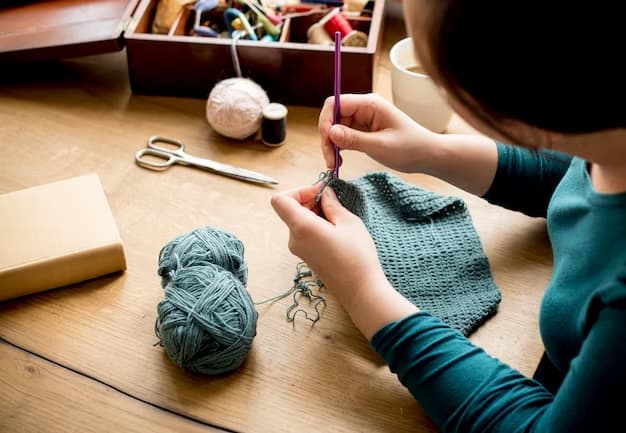Introduction to Double-Sided Knitting
Double-sided knitting, a technique characterized by creating two distinct layers of fabric simultaneously, eliminates the concept of a ‘wrong’ side. This article delves into the foundational aspects of double knitting, explaining how to execute it and discussing its diverse uses.
Fundamentals and Techniques of Double Knitting
Double knitting encompasses various methods that involve knitting two separate fabrics on a single needle. This is achieved by slipping stitches and/or managing two yarns in a manner that keeps one hidden from the front side. Key methods include:
- Knitting two separate pieces simultaneously;
- Crafting intricate colorwork;
- Creating fully reversible, double-thick fabric;
- Utilizing double knitting for circular projects on straight needles.
It’s essential to understand that double knitting is not a singular technique, but a collection of methods sharing the principle of simultaneous two-sided knitting.
Applications and Benefits of Double-Sided Knitting
The versatility of double knitting is evident in its applications, which range from producing reversible colorwork to knitting items like scarves and hats with no discernible wrong side. This method is particularly suited for projects requiring warmth, as the fabric is effectively doubled.
Reading Double Knitting Charts
Navigating double knitting charts is a critical skill for successfully implementing this technique. Charts represent each stitch and its color, guiding the knitter through the pattern. It’s important to interpret these charts accurately, keeping in mind the reversibility of the fabric and the pairing of stitches in contrasting colors.
Advanced Double Knitting Techniques
Double knitting is not limited to basic patterns. Advanced techniques allow for knitting two items at a time, such as socks or sweater sleeves, ensuring symmetry and consistency. Additionally, brioche stitches can be incorporated into double knitting for a voluminous, two-color effect.
By mastering the techniques and understanding the applications of double-sided knitting, knitters can significantly expand their skill set and enhance the complexity and beauty of their projects.
Comparative Table: Techniques in Double-Sided Knitting
| Technique | Description | Complexity | Suitable Projects | Reversible |
|---|---|---|---|---|
| Double Stockinette Stitch | Simplest form of double knitting, creating a reversible fabric | Easy | Scarves, warm flat items | Yes |
| Standard Double Knitting | Uses two yarns for colorwork, creating two layers | Intermediate | Colorwork, reversible hats, accessories | Yes |
| Two at a Time | Knitting two separate pieces simultaneously | Advanced | Socks, sleeves, symmetrical items | No |
| Brioche Stitches | Crosses yarns with every stitch for a voluminous effect | Advanced | Warm winter wear, textured designs | Partially |
Joining in the Round
When you decide to embark on a double-sided knitting project in the round, the process of joining your work seamlessly becomes crucial. Here, we’ll explore how to start knitting in the round for double-sided projects, ensuring that both sides maintain their distinct characteristics.
Starting with a Circular Cast-On
- Select Your Method: To begin double-sided knitting in the round, choose your preferred cast-on method. A long-tail cast-on or a provisional cast-on can work well;
- Even Stitch Count: Ensure that you cast on an even number of stitches. Symmetry is essential for double-sided knitting;
- Join the Ends: After casting on, ensure that your stitches are not twisted around the needle. Then, bring the two ends together to form a circle, making sure that the working yarn is at the right end;
- First Stitches: Begin knitting with your chosen technique, whether it’s the double stockinette stitch, standard double knitting, or any other method you’ve selected.
Keeping Track of Rounds
Maintaining an accurate count of your rounds is crucial in double-sided knitting to ensure both sides stay in sync. Here’s how to do it:
- Use Stitch Markers: Place stitch markers at regular intervals to indicate the start of a new round. This helps you keep track of your progress;
- Check Both Sides: Periodically inspect both sides of your work to verify that the colorwork or pattern is aligning correctly. Adjust as needed;
- Consider a Row Counter: Using a row counter can be especially helpful for intricate patterns or colorwork, allowing you to track your rounds precisely.
Closing the Gap
In double-sided knitting, you may encounter a small gap or jog when joining in the round. Here’s how to address it:
- Slip the First Stitch: When you start a new round, slip the first stitch from the left needle to the right one without knitting it. This smooths the transition and reduces the gap;
- Carry the Yarn Neatly: Pay attention to how you carry the yarn between colors. Keeping the yarn taut but not too tight can help minimize gaps;
- Blocking: After completing your project, blocking can work wonders to even out any minor irregularities and enhance the overall finish.
By following these steps, you can confidently begin your double-sided knitting in the round, ensuring that your project maintains its symmetry and distinct characteristics on both sides.
Conclusion
Double-sided knitting offers a world of creative possibilities, allowing knitters to produce intricate, reversible, and aesthetically pleasing fabrics. Whether you’re crafting a simple scarf using the double stockinette stitch or embarking on a more complex colorwork project with standard double knitting, this technique adds depth and warmth to your creations.
The ability to knit two layers simultaneously not only provides a reversible fabric but also opens up opportunities for functional items like warm winter accessories. Advanced techniques like knitting two pieces at a time or incorporating brioche stitches further expand the potential applications of double-sided knitting, making it a valuable skill in a knitter’s repertoire.
In conclusion, mastering the various techniques of double-sided knitting enriches your knitting experience, enabling you to tackle projects with enhanced complexity and creativity. Whether for practical purposes or artistic expression, double-sided knitting is a skill that offers endless opportunities for innovation and exploration in the knitting world.
